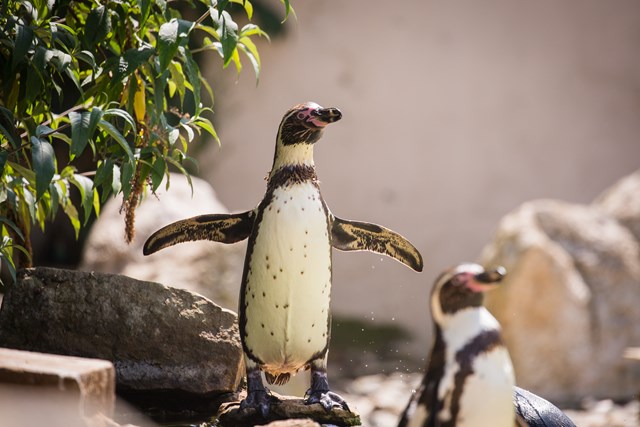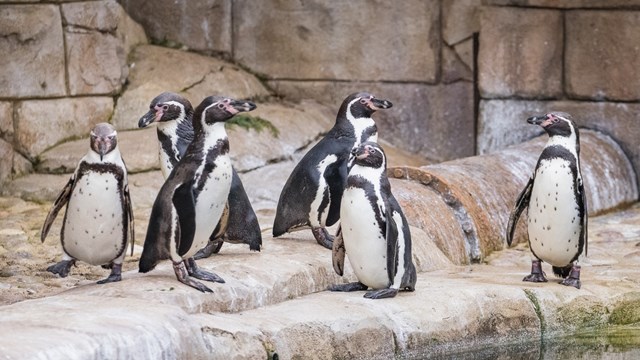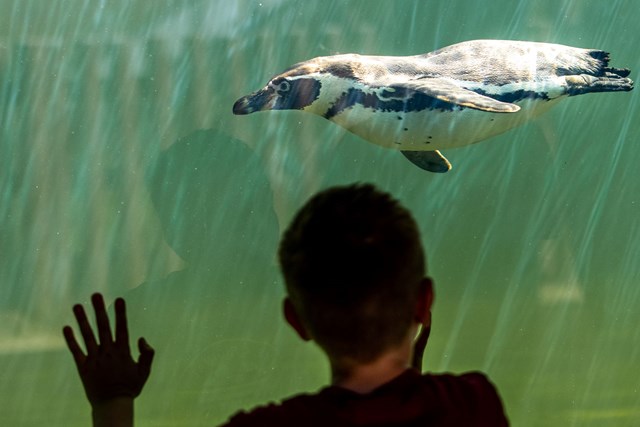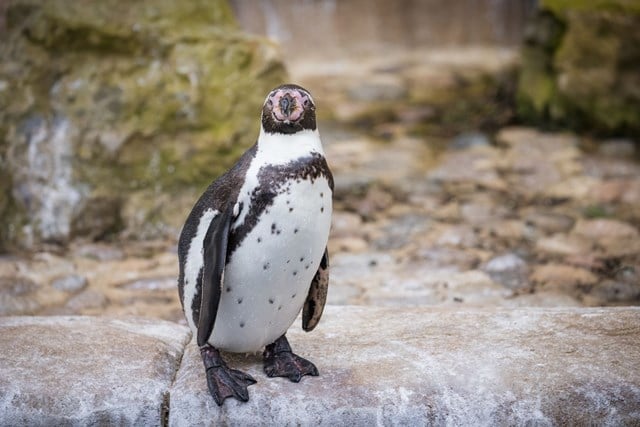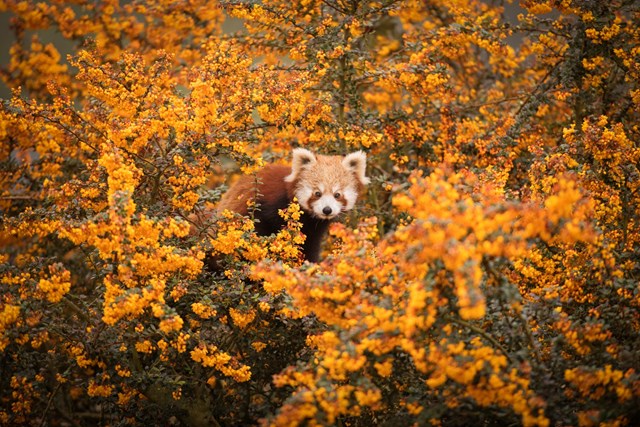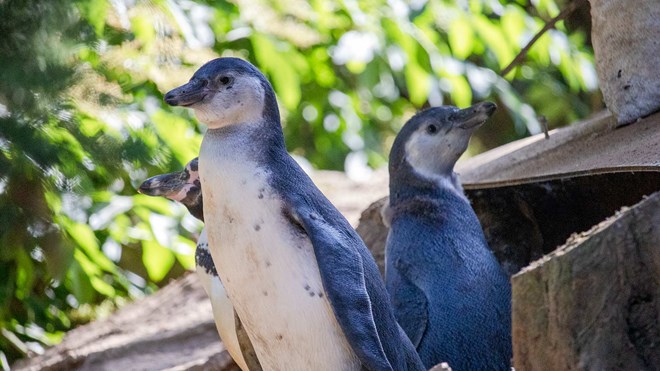
Overview
There is a large colony of Humboldt penguins living in a custom designed habitat at Woburn Safari Park.
Keepers recognise each individual penguin by the spot patterns on their chests, each one has a unique pattern which they keep throughout their life.
You will find them swimming in the pool, splashing around at feeding time, or busy in their nests on the hillside. Their distinctive braying calls can be heard from all around the Animal Encounters area of the Foot Safari.
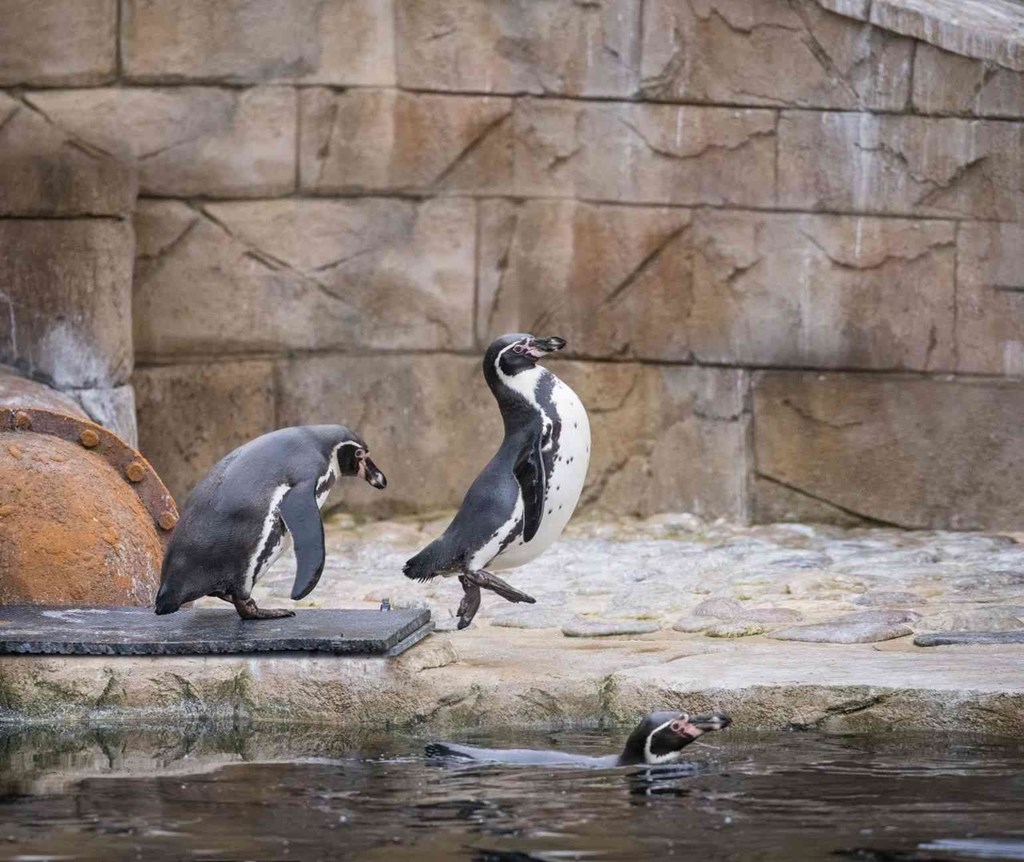
All about us
| Distribution: | Peru and Chile |
|---|---|
| Habitat: | Swimming in the Humboldt Current, nesting on coastlines with substantial guano deposits |
| Height: | Up to 64cm long |
| Weight: | 4kg |
| Lifespan: | Wild 15 - 20 years, captivity up to 30 years |
| Threats: | Over fishing, pollution, and guano harvesting |
Scientific name: Spheniscus humboldti
The Humboldt penguin is named after the strip of water it swims in, the Humboldt Current, but is also known as the Peruvian penguin because of the unusual location of this strip of water. They are found along the coast of Chile and Peru, unlike their colder climate relatives.

Humboldt penguin facts
In the cold water a thick coating of two layers of feather and a layer of blubber allows them to stay warm, dry, and waterproof. These feathers are tightly packed, and coated in oil secreted from the base of the tail which is rubbed into the fathers to help them stay waterproof. Penguins will preen their feathers and oil them before each fishing trip.
There are exposed patches of skin around the beak, and feet, which allow them to stay cool when on land. When they are hot this skin will be filled with blood, bringing it closer to air to cool, causing the penguins to blush.
Their torpedo shaped bodies allow them to move through the water with speed, with their feet positioned at the base of the body to power them through the water from behind. The bone structure of penguins differs from other birds in that it is designed to be heavy. The bones are solid and dense, allowing them to dive to depths of up to 150 feet, although the average dive is to 60 feet. The wings of a penguin are more like flippers to allow them to propel through the water, and cannot be used for flight.
Each year an annual moult takes place where a new set of feathers replaces the old one. This process only takes ten days, with new feathers pushing out the old. During this time the body is no longer waterproofed or insulated properly, leaving the penguin unable to swim.
The black and white colouration is known as counter shading. The dark back blends in with the sea below when viewed from above, and the white underbelly blends in with the light sky above when viewed from below.
Their vision is good both above and below water, allowing them to hunt well, and to recognise other penguins by sight.
Humboldt’s will form a monogamous pair for life, but can change partners if their partner dies, or if breeding is unsuccessful. They build their nest by digging burrows of a few metres deep into large deposits of guano, a build up of sea bird and seal excrement. These guano deposits are in serious decline due to guano farming, and so often they will have to build nests in rocky outcrops and scrapes instead.
Sexual maturity is reached between two to seven years of age. The penguin will then find a partner, and may build a practice nest, gathering egg shaped objects and sitting, before breeding. Breeding can occur all year round. Usually two eggs are laid, and incubation lasts forty to forty two days. Once the chicks are hatched it they will take five to ten weeks to grow their important layer of insulating feathers, until then they will not leave the nest. The parents will take it in turns to leave the nest and forage for food, which they then regurgitate for the chick. Even once they are able to swim the chick will rely on the parents for food, until the age of around six months.
Chicks will have a different colouration to the adults, a brown to grey colour instead of black, which they will lose when they have their first moult at around a year old.
Humboldt penguins are inshore feeders, eating a variety of small fish, but mostly anchovies, krill, and squid. They will at the fish head first to stop the scales being caught in the throat. The inside of the beak is coated in teeth like spines to allow gripping of swimming fish. Penguins will spend weeks at sea feeding, and can travel hundreds of kilometres from the colony to feed.
The El Niño, a natural phenomenon which happens every four to twelve years causing the warming of the sea around the coast of South America, can have negative effects on their feeding, causing die offs of fish, and so a shortage in food supply and increased mortality. It can also cause coastal swell causing nest sites to be flooded.
In the wild penguins would live in salt water, and catch live fish, as this is not the case in captivity we have to substitute these requirements with a supplement in their diet. Each morning every penguin is given a salt tablet and a fish-eater tablet. Each individual penguin is recognisable by the spot pattern on their chest, so each is given their tablets in a fish and ticked off a list.
The spot pattern on each penguin’s chest is unique to them, and will stay the same throughout their life throughout each moult and new set of feathers. This means we can learn to recognise patterns for each penguin to identify them, rather than putting artificial tags or markers on them.
In the wild penguins would dig burrow like nests into large guano deposits, here we do have some artificial nest boxes, but the penguins prefer to dig their own nests into the hillside. Each pair has their own nest which they return to each year, and many live in all year round. Just as they would in the wild they will mark it with their own guano to help recognise it.
Estimates suggest there are between 2,500 to 9,999 Humboldt penguins left in the wild, with populations decreasing annually. This population exists in around 20 small breeding colonies.
Natural predators include leopard seals, sharks, killer whales, Andean foxes, fur seals, sea lions, and domestic cats and dogs. Recent studies have found that the eggs are predated upon heavily by rats, and burrows suffer from other birds nesting above and collapsing them.
The El Niño, a natural phenomenon which happens every four to twelve years causing the warming of the sea around the coast of South America, can have negative effects on their feeding, causing die offs of fish, and so a shortage in food supply and increased mortality. It can also cause coastal swell causing nest sites to be flooded.
Their biggest threats are guano harvesting, overfishing, fishing nets, and pollution. The Guano, a build up of sea bird and seal excrement, they build their nests, in is a valuable resource used for fertilising crops. Farmers will harvest entire guano sites, destroying nests and disrupting colonies. This leaves chicks and eggs abandoned, it also forces the penguins to build new nests in rocky outcrops and small scrapes, making them much more vulnerable and exposed.
Over fishing has caused the exploitation of several of their main prey items, such as the anchovy, and the techniques used to fish, like drag nets, and the use of explosives, can kill them. Penguins have been caught for the use of their skin, and blubber in the past, and now more commonly for the pet trade, or for fishing bait. There is a large amount of industrial development occurring on the coastline, with the building of several coal power plants threatening populations in two major breeding sites in Chile.
There are several sustainable controlled guano harvesting projects ongoing, with guano harvesters signing contracts to protect penguins, only harvesting certain areas, and being monitored when doing so. There has also been a ban on the hunting of Humboldt’s since 1995 in Chile. Artificial nest boxes have also been provided in some areas to replace depleted guano sites, with some success.
They are part of an EEP, European Endangered Species Programme. The EEP is the most intensive type of population management for a species kept in European zoos. Each EEP has a coordinator, who is assisted by a Species Committee. They are responsible for collecting all the data on births, deaths, and transfers, carrying out demographical and genetical analyses, and producing a plan for the future management of the species. Together with the Species Committee, recommendations are made each year on which animals should breed or not breed, which individual animals should go from one zoo to another, and so on.
They are also part of the CMS, Convention on Migratory Species, also known as the Bonn Convention. The aim of this is to conserve migratory animals throughout their range. They are listed as appendix I, as they are a species threatened with extinction. This means that CMS parties are focused on protecting these animals, conserving or restoring the places where they live, fixing obstacles to migration and controlling other factors that might endanger them.
